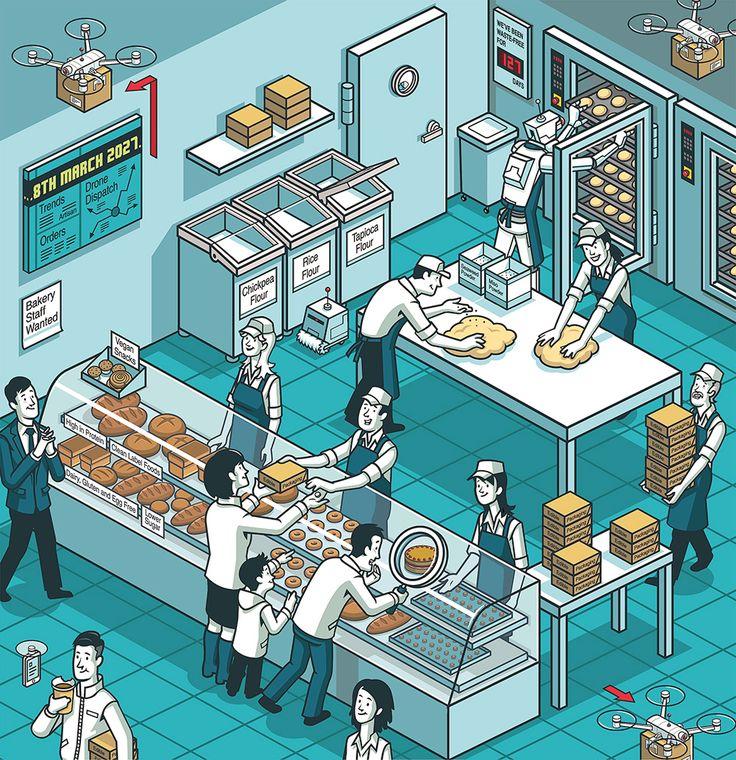Food Industry

Key Aspects of the Food Industry:
- Economic Significance: A vital sector within every country's economy, contributing significantly to GDP and employment.
- Public Health & Safety: Impacts public health through food safety regulations, nutritional content, and the promotion of healthy eating habits.
- Social Impact: Plays a crucial role in social development and community well-being.
- Key Areas: Encompasses a wide range of activities, including farming, production, processing, distribution, and retail.
Key Challenges:
- Food Safety & Quality: Ensuring food safety and quality throughout the entire supply chain remains a critical concern.
- Sustainability: Promoting sustainable agricultural practices and minimizing environmental impact.
- Consumer Trends: Adapting to evolving consumer preferences, such as demand for organic, healthy, and convenient food options.
- Competition: Navigating a highly competitive market with increasing globalization.
The food industry is constantly evolving, driven by technological advancements, changing consumer preferences, and increasing regulatory scrutiny.
Components of the Food Industry
The food industry encompasses a complex network of interconnected industries:
- Agriculture:
- Cultivation of crops, livestock farming, and aquaculture.
- Production of agricultural inputs like fertilizers, pesticides, and seeds.
- Food Processing:
- Transforming raw agricultural products into consumable goods.
- Includes processes like canning, freezing, and pasteurization.
- Food Distribution:
- Transportation, storage, and marketing of food products.
- Involves a robust network of suppliers, distributors, and retailers.
- Regulation:
- Government oversight to ensure food safety, quality, and compliance with regulations (e.g., FDA regulations in the US).
- Finance:
- Access to credit and insurance for businesses operating within the food industry.
- Financial management and accounting services for food businesses.
- Research & Development:
- Continuous innovation in food production, processing, and packaging.
- Market research to understand consumer preferences and trends.
- Marketing & Sales:
- Promoting food products through various channels, including advertising, marketing campaigns, and public relations.
The Modern Food Industry: Fueled by Innovation
Today's food industry is a testament to technological advancement. From farm to fork, innovation is driving unprecedented change.
- Automation & Robotics: Automation has revolutionized food production, from automated harvesting to robotic food preparation. This increased efficiency translates to higher productivity and profitability.
- Biotechnology & Precision Agriculture: Techniques like genetic engineering and metabolic engineering are optimizing crop yields and improving nutritional content.
- Advanced Food Processing: Technologies like high-pressure processing, ultrasound, and microwave technology are enhancing food safety, extending shelf life, and minimizing energy consumption.
- Nanotechnology: Nanotechnology is transforming food packaging, improving food delivery systems, and enhancing the nutritional value of food products.
- Blockchain Technology: Blockchain provides unparalleled traceability and transparency throughout the food supply chain, minimizing waste and improving food safety.
- Artificial Intelligence & Data Analytics: AI-powered solutions are optimizing logistics, predicting demand, and personalizing customer experiences.
- E-commerce Dominance: The rise of e-commerce has revolutionized food delivery, with online platforms connecting consumers with a vast array of food options.
The food industry is constantly evolving, embracing cutting-edge technologies to enhance efficiency, improve sustainability, and deliver innovative and high-quality food products to consumers worldwide.
The food industry, while a cornerstone of our society, faces numerous challenges:
- Sustainability:
- Minimizing environmental impact through sustainable agriculture, reducing food waste, and adopting eco-friendly packaging.
- Addressing climate change impacts on food production and distribution.
- Food Safety:
- Ensuring food safety throughout the entire supply chain, from farm to fork, to prevent foodborne illnesses.
- Meeting stringent food safety regulations and adhering to rigorous quality control standards.
- Consumer Demands:
- Adapting to evolving consumer preferences, such as demand for organic, healthy, and convenient food options.
- Meeting the growing demand for transparency and ethical sourcing practices.
- Competition:
- Navigating a highly competitive market with increasing globalization and the emergence of new competitors.
- Innovation:
- Continuously innovating to develop new products, improve production processes, and enhance consumer experiences.
- Regulatory Compliance:
- Complying with complex and ever-changing regulations related to food safety, labeling, and environmental protection.
- Supply Chain Disruptions:
- Managing risks associated with global supply chains, such as disruptions caused by natural disasters, geopolitical events, and pandemics.
Conclusion
The food industry plays a vital role in sustaining human life, providing nourishment and contributing significantly to economic growth. However, it also faces numerous challenges, including ensuring food safety, promoting sustainability, and adapting to evolving consumer demands.
The food industry is a dynamic and ever-evolving sector, constantly adapting to new technologies, consumer preferences, and global challenges.